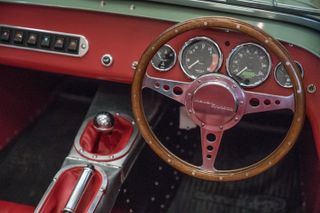Why you can trust TechRadar
Performance
- 20fps burst shooting
- 5-axis image stabilization
- 480-shot battery life
Raise the camera up to your eye and start rattling off bursts of shots at 20fps with no viewfinder blackout, and the Sony Alpha A9 really does feel like the product of witchcraft.
It's almost a little unnerving at first, but you quickly embrace the stunning capabilities of the camera. Helpfully, there's a subtle 'shutter' sound to reassure you that something is actually happening, though you can switch to fully silent operation via the menu if required.
If a burst rate of 20fps is overkill for what you're shooting, you also have two slower drive modes to choose from, while those looking to use a lens adapter (something that's likely given the limited range of longer focal length lenses) will see the Alpha A9's burst shooting performance cut in half to 10fps.
The viewfinder itself is excellent – the 120fps refresh rate and the clarity of the 3,686k-dot resolution combine to provide a beautifully clear and large view of what you're shooting. Whether you have a preference for this over the big and bright optical viewfinders on the A9's DSLR rivals will come down to you; optical viewfinders still have the edge in high-contrast and poorly lit scenes, but the EVF on the Alpha A9 provides a real-time look at how the camera is going to capture the scene – and you can't ignore that blackout-free burst shooting.
Battery life has been bumped up from the Alpha A7R II to deliver 480 shots, but when put up against the EOS-1D X Mark II's 1,210 shots and the D5's staggering 3,780 shots this looks a little paltry, especially if you're going to be holding the shutter down at 20fps for long periods. It goes without saying then that you're going to need spare batteries – and more than one if you're a working photographer.
Image quality
- ISO100-51,200, expandable to 50-204,800
- Good ISO performance
- +/-5 EV exposure compensation in 1/3 or 1/2 stop increments
Landscape and studio photographers should still plump for the more densely populated 42.2MP Alpha A7R II, but that's not to say the sensor inside the Sony Alpha A9 falls short – far from it.

The 24MP sensor is capable of delivering images rich in detail, especially when married with some of Sony's G-Master lenses, and results compare very favorably to those from the slightly lower-resolution EOS-1D X Mark II and D5. You should have no qualms about producing sharp Super A3 prints, while A2 sized prints are a reality too.

The Alpha A9 also holds its own against its rivals when it comes to high-ISO performance. Looking at JPEG files, even at ISO12,800 results look very good; there's a slight hint of luminance (grain-like) noise, but, while detail has been compromised, the overall result is perfectly useable. Raw files at the same sensitivity see some chroma (color) noise appear, but detail is that bit better, and you have the option to apply noise reduction to taste in post-processing.
All told it's very impressive, and while the A9 doesn't quite eclipse the high-ISO performance of our low-light king, the D5, you have to really pixel-peep to see the differences.


The A9's dynamic range performance, while not quite a match for that of the A7R II, is still broad enough in the real world to enable you to recover a decent amount of highlight detail from raw files. It also copes well with shadows – we found that we could happily drag the Shadows slider in Adobe Camera Raw a good way to the right without the image deteriorating.
Current page: Performance and image quality
Prev Page Build, handling and AF Next Page Verdict and competitionPhil Hall is an experienced writer and editor having worked on some of the largest photography magazines in the UK, and now edit the photography channel of TechRadar, the UK's biggest tech website and one of the largest in the world. He has also worked on numerous commercial projects, including working with manufacturers like Nikon and Fujifilm on bespoke printed and online camera guides, as well as writing technique blogs and copy for the John Lewis Technology guide.

